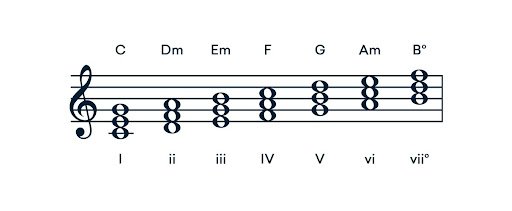
Can Major Keys Sound Sad?
https://youtu.be/SP-F7VfVhP0
If you’ve been taught the differences between major and minor keys, you might beg yourself the question: can major keys sound sad? The answer is A RESOUNDING YES. One could even say a major key can sound more depressing than a minor key. But how? Aren’t major keys known to be the “happy sunshine” sibling while minor keys are the “sad emo” one? The answer lies in the way the chords of a major key can be combined to create a bittersweet longing for what once was.
The Major 7th
Let’s take a look at what chords are in a major scale, using the key of C major as reference:

Audio 1: Chords of the Major Scale
Look at the names of the chords and notice that there are three major chords, but also three minor chords. If you had the belief that major chords sound happy and minor chords sound sad, you’re absolutely right. The trick to having the major chords sound as sad as the minor chords is to pair them with notes from their more depressing counterparts.
How do you know which chords to pair? Look at the C chord and notice that it shares its top two notes with Em. Add that B at the top of Em to the C chord, and create of the most famous chord types in all of contemporary music: the major 7th.
Earlier, we established that sadness in a major key evokes a bittersweet longing for what once was. Why is that? By combining the major chord of C with the Em chord, we’ve created a sound that one could describe as “incomplete”. This is done through the dissonance the B creates with the C. Since the B is only a half-step away from becoming a C and falling in line with the rest of the chord, it makes us want to feel happy. However, it prevents us from getting all the way there.
The same goes for the F chord. It shares its top two notes with Am. Combine the two, and you’ll yield the same result.
The V Chord
The G chord is tricky, which is called the dominant in this key. You’ll follow the same pattern by pairing it with the chord that shares two notes with it. You have two options: B˚, which shares G’s top two notes, and Em, which shares G’s bottom two notes.
When paired with B˚, the resulting chord is what’s called a dominant 7th. This chord is the cornerstone for most western classical music. This is because of its tritone (the interval between the B and F) and tendency to resolve back to the root chord. While this is used in plenty of sad music and is extremely useful, it doesn’t sound particularly sad on its own.
If you pair it with Em, the result is what’s called a minor 7th chord. This is also called a major chord with add 6, depending on its inversion. It still combines a major chord with a minor chord, the dissonance here between D and E is milder. This is because they’re a whole step apart instead of a half step.
Audio 3: The Dominant 7th (V7)
The Relative Minor
Every major key also has a relative minor key. This means that both keys use the same scale, or set of notes. In the case of C major, our parallel minor is Am. Since the C major scale is played using all the white keys from C to C, the case is the same as playing all the white keys from A to A to get the Am scale.

This reminds us of the fact that both minor and major keys hold the same amount of minor and major chords. However, their differences lie in which tonal centers they adhere to. Therefore, changing how different chords gravitate from one to another. A major key momentarily adapts the behavior of its relative minor and sounds sadder than the rest of the piece.
In recent years, AI music generators have started rolling out with option to create songs in major and minor keys. It’s interesting to notice how some of these tools offer genre like “dark trap” with the option for a major key. Instead of using major chords, they tend to switch to the relative minor. So if the user select the dark genre and a major key, it will deliver a song in the relative minor key, for example.
Conclusion
These ways of using the major key are used widely by film composers to score sad scenes. In fact, it’s so popular that you’ll instantly be able to recognize the type of music it creates (Pixar, anyone?). Adding these sorts of extensions to chords is also the basis of most jazz music, so this can also be used in that context.
When writing or playing your own music, experiment with these ideas and see where it takes you. There is plenty that can be done past just stacking these chords together, such as playing them in succession to one another or transforming the other minor chords into minor 7ths as well. What we talked about here applies to all 12 major keys, so it’ll translate perfectly no matter what your root note is.